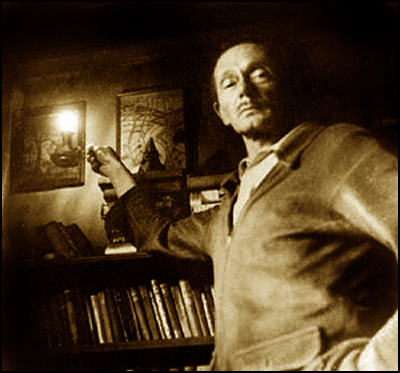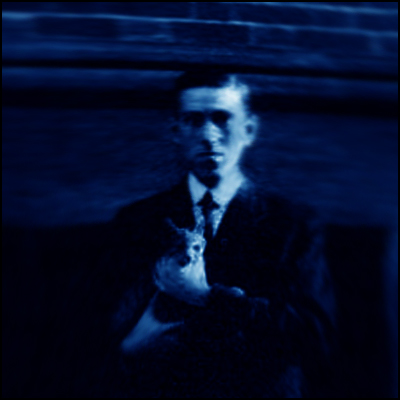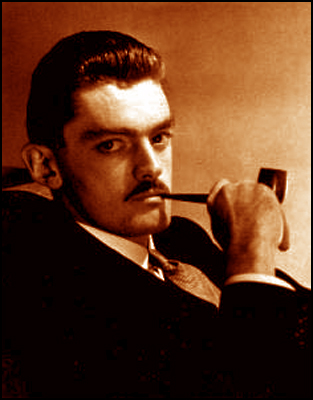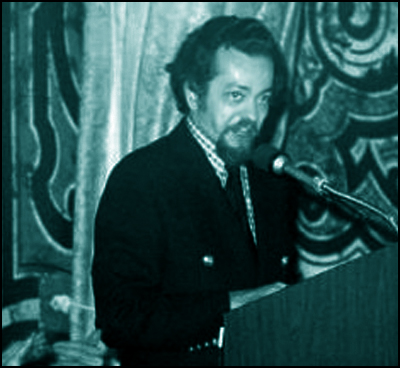Ze, Mozadrim, Vachama Vongh Razan*
Tuesday, October 16, 2007
posted by Steve Tompkins
 Print This Post
Print This Post

The Selected Letters of Clark Ashton Smith has long since figured in a first-rate post by Leo, but acquisitions for my weird fiction library sometimes require me to pinch the first and best Republican president right off the face of every penny, and it wasn’t until last month that I lucked into an affordable copy at Addall.com. The book really is a garden of unearthly, flower demon-type delights, so many thanks to editors Scott Connors and David E. Schultz. CAS shows that the baleful late Thirties zeitgeist is not lost on him with this fine Howardian sentiment near the end of a September 9, 1937 letter to Robert Barlow: “Incidentally, the word ‘civilization’ would make a jackal vomit in view of the general situation.” And another aside to Barlow in the same letter is as amusing as Howard’s sly suggestion that Lovecraft should fictionalize one of his own “sex adventures” in order to crack the spicies:
HPL, however, should have written [a story about the Last Sabbat] himself. I can’t hope to compete with him when it comes to New England setting and atmosphere; though perhaps the actual orgies of the Sabbat would be a little more in my line.
But what really caught my eye were several letters that may well have been discussed to death in Esoteric and Dagonian precincts; S. T. Joshi certainly cites one on page 639 of his Lovecraft biography. Still, it seems to me that the cumulative impact of the letters in question and a possible extra resonance for Howardists just might justify a blog-post. I’m referring to nothing less than an early attempt by CAS to save Derleth from himself — and more importantly, save Lovecraft from distortion and dilution.

In an April 13, 1937 letter Smith cautions “I shouldn’t class any of the Old Ones as evil: they are plainly beyond all limitary human conceptions of either ill or good.” Next comes “Personally, I don’t think it necessary to enter into quite so much detail in presenting the stories to intelligent readers; but the growth of the whole mythos, the borrowings and contributions by various writers, is certainly an interesting study.” And in an envelope P.P.S., Smith is willing to grant “Of course the Old Ones might be considered relatively evil, since the overwhelming horror and hideousness of their aspect, their ravenousness toward man, etc., are always emphasized.” But he stresses “These qualities of terror and horror would seem to inhere in their sheer alienage; and all things equally akin would have the same or kindred effect on human sentiency.”
On April 21, 1937 CAS queries “the grouping of ‘The Colour out of Space’ amid the Mythology tales, since it seems to me that the incursive agency in this tale is merely an unknown cosmic force, hardly to be classed as supernatural or even animate.” And then, a judicious tap that should have sufficed to induce spiderweb fractures throughout the stained-glass curtain behind which Derleth would soon obscure Lovecraft’s work:
A deduction relating the Cthulhu mythos to the Christian mythos would indeed be interesting, and of course the unconscious element in such creation is really the all-important one. However, there seems to be no reference to expulsion of Cthulhu and his companions in “The Call”…When the stars were “right” some outside force would serve to liberate and resurrect them. This would seem to indicate the action of cosmic laws rather than a battle between good and evil deities. However, the passage that you quote from a letter to Farnese would seem to give the problem another complexion. However, if the “expulsion” was accompanied by animate agencies or gods, it is strange that they are not referred to in the stories.
Yes, it is strange — passing strange. That “letter to Farnese,” which Messrs. Connors and Schultz refer to as a “botched paraphrase by Harold Farnese” has caused as much trouble in weird fiction as the Donation of Constantine did in late antiquity.

April 28 finds CAS terming Derleth’s “The Return of Hastur” a “remarkable production,” and yet not “very satisfactory.” And then he warns the future arch-Arkhamite of the ichor-slippery slope that lies in wait: “One reason, confirmed rather than diminished by the second reading, is that you have tried to work in too much of the Lovecraft mythology and have not assimilated it into the natural body of the story.” As a result, “Cthulhu and the sea-things of Innsmouth” are more “a source of confusion” than “an element and interest of conflict.” Of the “varying references to the mythos in different tales” Smith ventures to suggest that they’re meant to reflect “diverse developments and interpretations of old myths and deities that spring up over great periods of time and in various races and civilizations” — strikingly similar to the illusions of multi-sourced depth and diffusion Tolkien took such pains to create en route from The Book of Lost Tales to The Silmarillion.
On May 13, 1937, Smith tries again:
As to the Lovecraft mythos, probably he had no intention or desire of reducing it to a consistent and fully worked out system, but used it according to varying impulse and inspiration. The best way, it seems to me, is to enjoy each tale separately and without trying to link it closely with all the others.
No Solar Pons should have been necessary for Derleth to deduce Smith’s superior insight/instincts here. Note the crucial Klarkashtonian choice of verb in that first sentence: reducing it to a consistent and fully worked out system. To substitute a system for a mythos is automatically to engage in reduction, to diminish, to rely on perspiration where once inspiration held sway. The demiurge’s wizardly staff gives way to the vivisectionist’s scalpel; paradise is paved so that a parking lot can be put up. And off we go to The Lurker at the Threshold (1945), The Mask of Cthulhu (1958), The Trail of Cthulhu (1962), a wing-clipping demotion to water elemental for the lord of R’lyeh, and the how-many-thousand-younged-she-goats-can-dance-on the-head-of-a-pin scholasticism of Brian Lumley’s The Burrowers Beneath and Lin Carter’s “Zoth-Othmog.”
Later in that same letter, CAS gently suggests that Derleth went astray in “Hastur” due to “an intensified preoccupation with the Cthulhu mythology,” and that preoccupation would impel the Comte D’Erlette to clamber somnambulistically aboard the tumbril cart that would take his reputation straight to Madame la Guillotine. So I’m fascinated by the epistolary evidence that years before Leiber’s “A Literary Copernicus” — “. . .and I believe it is a mistake to regard the beings of the Cthulhu mythos as sophisticated equivalents of the entities of Christian demonology or to attempt to divide them into balancing Zoroastrian hierarchies of good and evil” — and decades before Richard Tierney’s “The Derleth Mythos” and Dirk Mosig’s “H. P. Lovecraft: Myth-Maker,” a creator uniquely qualified to experience Lovecraft’s fiction at the same altitude of artistry not only spotted the pitfalls but pointed them out to the pitfall-prone posthumous collaborator/elaborator.
Mosig’s peroration in the aforementioned essay has always caused this Howardist’s heartbeat to race like the William Tell Overture: “The Lovecraft oeuvre can be regarded as a significant contribution to world literature — may it be remembered without the ‘adornments,’ ’embellishments,’ and ‘improvements’ contributed by his ‘self-blinded, earth-gazing’ imitators!” That’s what some of us have always wanted for REH; would that a figure of Smithian stature had sought to dissuade L. Sprague de Camp from his follies a la CAS with Derleth in 1937. Was CAS himself ever exposed to the Gnome Press volumes? They aren’t mentioned in the missives to de Camp in Selected Letters. In 1933 Smith had this to say to Derleth: “The Conan tales in my opinion, are quite in a class by themselves,” so my guess is he would have held the Gnomes to a higher standard than the last couple were equipped to meet.

Had Lovecraft still been around in the Fifties he might have counseled de Camp to stick the Howard-flouting deus of The Return of Conan back in its machina:
Then he seemed to see, superimposed on the grinning and slavering waifs of darkness, the picture of a great hall. giant logs were its walls, and the rafters were as thick as four men, but gloom pervaded it. Dark and somber men in gray mail stood about a throne. Upon the throne sat a black-haired king, tall and moody, with black eyes in an austere and merciless face. And the voice of this king reached out to his mind:
“Man of Cimmeria! You are a son of Crom and he will not let you suffer eternal damnation! You have always been true to him in your heart, and the black arts of the East shall not have your soul!”
The dark eyes of the god burned. He stretched out his powerful hand, and a great light burst from it. Conan felt all his old power surge back into his body.
Gack. How can those who wanly post that the first set of pastiches “aren’t that bad” at Conan.com or the REH-Comics newsgroup not notice pratfalls like this? If anyone needs to be reminded what the problem is, here’s Conan on Crom in “Queen of the Black Coast”:
“…What use to call on him? Little he cares if men live or die. Better to be silent than to call his attention to you; he will send you dooms, not fortune.”
Of The Return of Conan de Camp wrote “[Bjorn] Nyberg had the courage to sit down and write a whole novel about Conan, in a language that was not his mother tongue. This endeavor resulted in a collaboration between Nyberg and myself…” If it was Nyberg’s idea to trundle the newly benevolent Crom onstage, de Camp, the senior partner and the one who was at home in English, should have overruled him. A straight line of deviationism from Howard stretches superhighway-like from the buttinsky-deity on up through the clumsy interpolated paragraph in “The Hyborian Age,” with its erroneous reference to “the Lemurian migration that founded the kingdom of Stygia,” the continued suppression of “The Black Stranger” in favor of “The Treasure of Tranicos,” the nonsense about an “Elder Cimmeria” contemporaneous with Atlantis in Conan of the Isles, and the horrors of the blustering Sigurd of Vanaheim and the scampering Conn.

Those last two were mostly the fault of the man who would supplant Nyberg as de Camp’s junior-partner-in-posthumous-collaboration, who during the Gnome Press years was foreshadowing just how ill-suited to the job he would be with prodigies of buttering up the living writer at the expense of the dead one like this March 1956 review of Tales of Conan (from a fanzine called Inside and Science Fiction Advertiser #14):
I’ve always felt that Howard’s style had certain important flaws. Now I’m not arguing a matter of literary style — Howard was an unabashed pulp writer, making no pretensions of being a prose artist — but, nonetheless, there are things about Conaniana that bother me. The background texture was always a jumble of semi-history, mythology, pure invention; loaded with anachronisms. I always felt that Howard didn’t know much about military tactics, the nomenclature of early and medieval weapons, or anthropological data on how the feudal folk really lived.
Now along comes de Camp, an awesomely well-read and erudite gentleman, and a writer I’ve always had the greatest admiration for, to edit and partially rewrite some extant Howard manuscripts. The mixture of Howard’s blood and thunder heroics with de Camp’s detailed cultural knowledge lends the stories a flavor of authenticity without hampering in the slightest the raw and bawdy swashbuckling of Howard. The posthumous collaboration is an extremely felicitous one.
Valka, what a lickspittle twit. Didn’t know much about military tactics — as if Carter’s battles are now taught at West Point.
It’s worth mentioning that Scott Connors objects to the scapegoating of Derleth in his fair-and-balanced-in-the-non-Fox-Newsian-sense “The Shadow of August Derleth” piece, pointing out that the Wisconsinite’s Mythos stories were a way of pulling a Herbert West and reanimating Lovecraft — with, of course, affection and admiration. Similarly, there’s no doubting that de Camp was the sincerest of Conan fans. But in both cases we’re left with a variation on the Wildean dictum that each man kills the thing he loves. Each man travesties the reading material he loves? Sure, Derleth and de Camp were enthralled readers, but they weren’t particularly attentive ones. The former should have heeded CAS; the latter was wont to remark with arguably genuine ruefulness in the letters he contributed to REHupa Mailings in the mid-Nineties that it would have been helpful to have the input of his critics back when he was making the key decisions.
Whom the gods would destroy, they first make pigheaded.
*Translation: “Yes, master, the reanimated corpse will do the rest” — the “last line of a sorcerer’s invocation” from The Dead Will Cuckold You, which CAS shared with de Camp in a November 3, 1953 letter.
